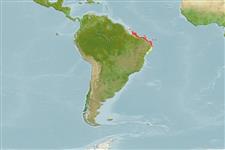Environment: milieu / climate zone / depth range / distribution range
Ecology
Marine; demersal; depth range 2 - 60 m (Ref. 58047). Tropical
Western Atlantic: northeastern Brazil and the mid-Atlantic ridge. Eastern Atlantic: Ascension Island.
Size / Weight / Age
Maturity: Lm ? range ? - ? cm
Max length : 51.2 cm TL male/unsexed; (Ref. 13121)
Found in holes and crevices, sometimes among weed. Possibly a protogynous hermaphrodite (Ref. 32169).
Life cycle and mating behavior
Maturity | Reproduction | Spawning | Eggs | Fecundity | Larvae
Protogyny unconfirmed (Ref. 84746).
Lubbock, R. and A. Edwards, 1981. The fishes of Saint Paul's Rocks. J. Fish Biol. 18(2):135-157. (Ref. 13121)
IUCN Red List Status (Ref. 130435: Version 2024-1)
Threat to humans
Harmless
Human uses
Tools
Special reports
Download XML
Internet sources
Estimates based on models
Preferred temperature (Ref.
123201): 27.2 - 27.5, mean 27.4 °C (based on 30 cells).
Phylogenetic diversity index (Ref.
82804): PD
50 = 0.5010 [Uniqueness, from 0.5 = low to 2.0 = high].
Bayesian length-weight: a=0.00049 (0.00024 - 0.00099), b=3.26 (3.10 - 3.42), in cm total length, based on LWR estimates for this (Sub)family-body shape (Ref.
93245).
Trophic level (Ref.
69278): 3.8 ±0.6 se; based on size and trophs of closest relatives
Resilience (Ref.
120179): Medium, minimum population doubling time 1.4 - 4.4 years (Preliminary K or Fecundity.).
Fishing Vulnerability (Ref.
59153): Moderate vulnerability (40 of 100).
